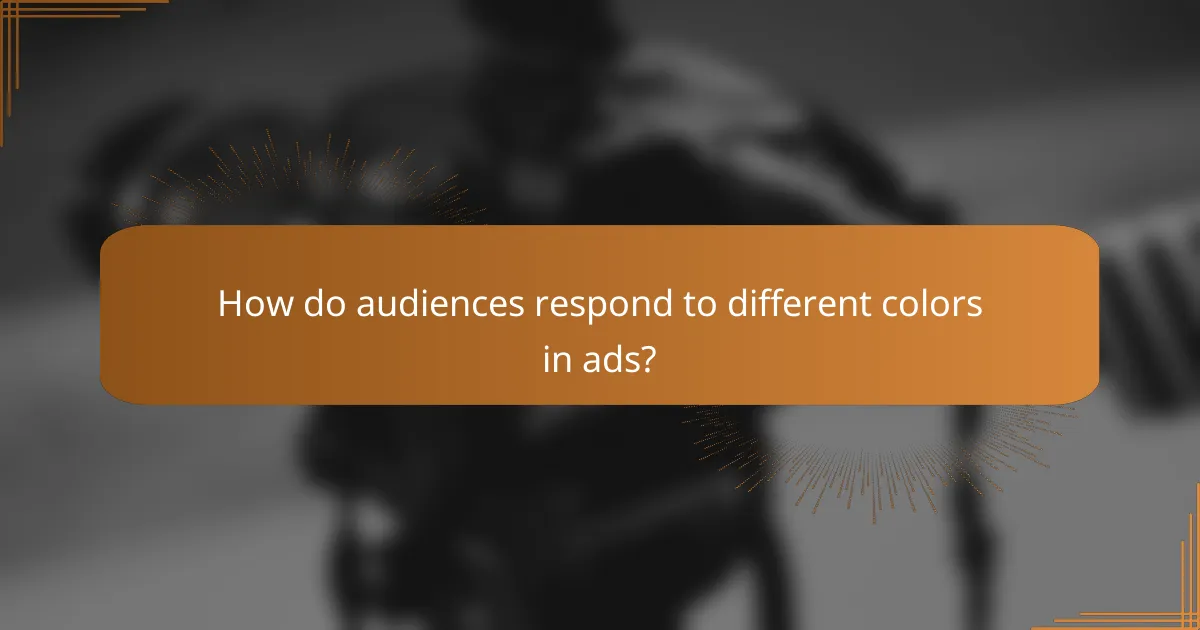Display advertising leverages color psychology to enhance viewer engagement and emotional response, significantly impacting campaign performance. By strategically selecting colors, advertisers can improve brand recognition and influence consumer behavior, ultimately driving conversions. Understanding key performance metrics such as click-through rate and return on ad spend is crucial for optimizing advertising strategies and achieving desired outcomes.

How does color psychology impact display advertising performance?
Color psychology significantly affects display advertising performance by influencing viewer emotions and perceptions. The right color choices can enhance brand recognition, evoke desired feelings, and drive user actions, ultimately impacting conversion rates.
Color influences emotional response
Colors evoke specific emotional responses that can shape consumer behavior. For instance, blue often conveys trust and reliability, making it popular among financial institutions, while red can create a sense of urgency, ideal for clearance sales. Understanding these associations helps advertisers craft messages that resonate with their target audience.
To leverage color effectively, consider the cultural context as well. For example, while white symbolizes purity in many Western cultures, it may represent mourning in some Eastern cultures. Tailoring color choices to the audience’s cultural background can enhance emotional engagement.
Different colors drive specific actions
Different colors can prompt specific actions from viewers. For example, green is frequently associated with health and wellness, making it an effective choice for promoting eco-friendly products. Conversely, orange is often used for call-to-action buttons because it stands out and encourages clicks.
When designing display ads, use color strategically to guide user behavior. A/B testing different color schemes can provide insights into which colors lead to higher engagement and conversion rates. Aim for a harmonious color palette that aligns with your brand identity while also motivating the desired action.

What performance metrics are essential for display advertising?
Essential performance metrics for display advertising include click-through rate (CTR), conversion rate, and return on ad spend (ROAS). These metrics help advertisers evaluate the effectiveness of their campaigns and make data-driven decisions to optimize performance.
Click-through rate (CTR)
Click-through rate (CTR) measures the percentage of users who click on an ad after seeing it. A higher CTR indicates that the ad is engaging and relevant to the audience. Generally, a good CTR for display ads ranges from 0.5% to 2%, but this can vary by industry and campaign type.
To improve CTR, focus on creating compelling ad copy and using eye-catching visuals. A/B testing different ad designs and messages can also help identify what resonates best with your audience.
Conversion rate
The conversion rate reflects the percentage of users who complete a desired action after clicking on an ad, such as making a purchase or signing up for a newsletter. A strong conversion rate typically falls between 1% and 5%, depending on the industry and the nature of the offer.
To enhance conversion rates, ensure that landing pages are optimized for user experience and aligned with the ad’s message. Clear calls to action and streamlined navigation can significantly impact the likelihood of conversions.
Return on ad spend (ROAS)
Return on ad spend (ROAS) measures the revenue generated for every dollar spent on advertising. A ROAS of 4:1, meaning $4 in revenue for every $1 spent, is often considered a benchmark for successful campaigns. However, acceptable ROAS can vary based on business goals and industry standards.
To maximize ROAS, regularly analyze campaign performance and adjust targeting, bidding strategies, and ad placements. Monitoring trends and seasonality can also help in allocating budgets effectively to achieve better returns.

How do audiences respond to different colors in ads?
Audiences respond to different colors in ads based on emotional triggers and psychological associations. Colors can evoke specific feelings and influence consumer behavior, making it essential for advertisers to choose colors that align with their target audience’s preferences and cultural context.
Target demographic preferences
Different demographics often have varying color preferences that can significantly impact ad effectiveness. For instance, younger audiences may prefer vibrant and bold colors, while older consumers might gravitate towards more subdued and classic tones. Understanding these preferences can help tailor advertising strategies to resonate better with specific groups.
Conducting surveys or analyzing existing data can provide insights into the color preferences of your target demographic. For example, blue is frequently associated with trust and reliability, making it a popular choice for financial services aimed at a broad audience.
Cultural significance of colors
The cultural significance of colors varies widely across different regions and societies. For example, while white is often associated with purity and weddings in Western cultures, it can symbolize mourning in some Eastern cultures. Advertisers must consider these cultural meanings to avoid misinterpretation and ensure their messages are received positively.
When designing ads for international markets, it’s crucial to research the local cultural context. A color that works well in one country may not have the same effect in another. For instance, red can signify good fortune in China but may evoke caution in other cultures. Tailoring color choices to fit cultural significance can enhance audience engagement and brand perception.

What are the best practices for using color in display ads?
Effective use of color in display ads can significantly enhance viewer engagement and conversion rates. To maximize impact, consider the psychological effects of colors, test variations, and ensure alignment with your brand identity.
Testing color variations
Testing different color variations is crucial for determining which hues resonate best with your audience. A/B testing can help you compare performance metrics like click-through rates and conversion rates across different color schemes.
When conducting tests, focus on a few key colors rather than overwhelming your audience with too many options. Aim for a testing period of at least one to two weeks to gather sufficient data for analysis.
Aligning color with brand identity
Colors should reflect your brand identity to create a cohesive visual experience. For instance, if your brand is associated with trust and reliability, consider using blue tones, while vibrant colors like red can evoke excitement and urgency.
Ensure that the colors used in your display ads are consistent with your overall branding strategy. This consistency helps reinforce brand recognition and can improve customer loyalty over time.

What frameworks help evaluate display ad effectiveness?
To evaluate display ad effectiveness, marketers commonly use frameworks like attribution models and A/B testing methodologies. These frameworks provide insights into how ads perform and how audiences respond, enabling data-driven decisions for optimization.
Attribution models
Attribution models help determine which marketing channels contribute to conversions. They assign credit to various touchpoints in the customer journey, allowing marketers to understand the effectiveness of their display ads relative to other channels.
Common models include first-click, last-click, and multi-touch attribution. For example, a last-click model gives full credit to the final ad a user interacted with before converting, while multi-touch considers all interactions, providing a more comprehensive view.
When choosing an attribution model, consider your campaign goals and customer behavior. Avoid relying solely on last-click models, as they may undervalue earlier interactions that played a crucial role in the conversion process.
A/B testing methodologies
A/B testing methodologies involve comparing two versions of an ad to determine which performs better. This method allows marketers to test variables like color, copy, and placement, providing actionable insights into audience preferences.
To conduct A/B testing effectively, define clear objectives and ensure a sufficient sample size for statistical significance. For instance, if testing two different headlines, run the test long enough to gather meaningful data, ideally over several days or weeks.
Be cautious of common pitfalls, such as testing too many variables at once or drawing conclusions from insufficient data. Stick to one change at a time to isolate its impact on performance, ensuring reliable results for future campaigns.

How can display advertising strategies evolve with color trends?
Display advertising strategies can evolve by incorporating current color trends that resonate with target audiences. By staying attuned to emerging palettes and seasonal shifts, advertisers can enhance engagement and improve overall campaign performance.
Emerging color palettes
Emerging color palettes often reflect cultural shifts and consumer preferences. For instance, muted tones and earthy colors have gained popularity, appealing to audiences seeking authenticity and sustainability. Advertisers should consider integrating these palettes into their campaigns to create a more relatable brand image.
To effectively utilize emerging colors, brands can conduct A/B testing with different color schemes to determine which resonates best with their audience. This data-driven approach helps refine advertising strategies and optimize visual appeal.
Impact of seasonal color trends
Seasonal color trends can significantly influence consumer behavior and purchasing decisions. For example, warm colors like red and orange are often associated with fall promotions, while cool colors like blue and green may be more effective in spring campaigns. Understanding these associations can help advertisers time their campaigns for maximum impact.
Brands should regularly update their color strategies to align with seasonal trends, ensuring their advertisements remain fresh and relevant. Monitoring industry reports and design forecasts can provide valuable insights into upcoming color trends, allowing for proactive adjustments in advertising strategies.

What future trends in color psychology should advertisers consider?
Advertisers should focus on emerging trends in color psychology that influence consumer behavior and engagement. Understanding how colors evoke emotions and perceptions can enhance ad effectiveness and audience connection.
AI-driven color optimization
AI-driven color optimization utilizes algorithms to analyze audience preferences and predict which colors will resonate best with specific demographics. By processing vast amounts of data, advertisers can tailor their color schemes to maximize engagement and conversion rates.
For instance, an AI tool might suggest using warmer colors for a campaign targeting younger audiences, as studies indicate they often respond positively to such hues. Implementing these insights can lead to more effective ad designs that align with audience expectations.
Personalization through color choices
Personalization in advertising increasingly involves customizing color choices based on individual user data. By leveraging insights from past interactions and preferences, brands can create tailored experiences that enhance user engagement.
For example, an online retailer might change the color of a call-to-action button based on a user’s browsing history, opting for colors that have previously led to higher click-through rates. This approach not only improves user experience but also drives higher conversion rates.


